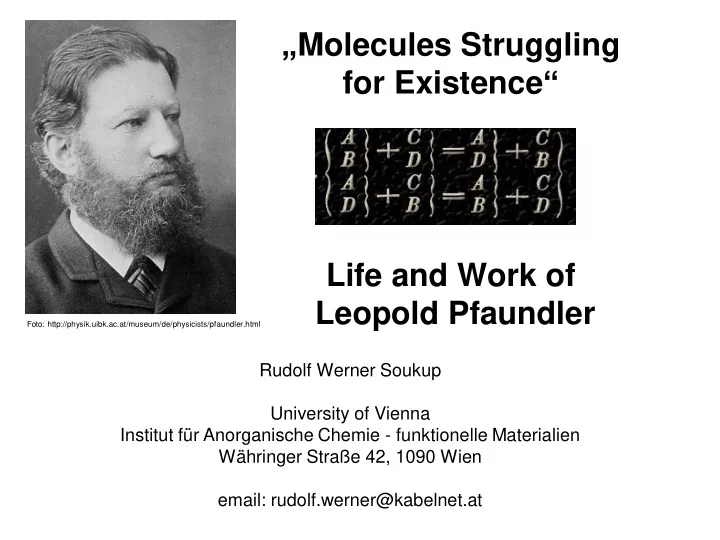

„ Molecules Struggling for Existence “ Life and Work of Leopold Pfaundler Foto: http://physik.uibk.ac.at/museum/de/physicists/pfaundler.html Rudolf Werner Soukup University of Vienna Institut für Anorganische Chemie - funktionelle Materialien Währinger Straße 42, 1090 Wien email: rudolf.werner@kabelnet.at
American Chemical Society Division of the History of Chemistry Citations for Chemical Breakthrough Awards 2016 Awardees L. Pfaundler “Beitrag zur Chemischen Statik,” (Poggendorff) Annalen der Physik und Chemie , 1867, 131 , 55-85. Universität Innsbruck, Austria
1848 - 1856: Pfaundler was educated at the “ Akademisches Gymnasium ” in Innsbruck http://www.veikkos-archiv.com/index.php?title=Datei:W0247244.jpg https://www.uibk.ac.at/universitaet/ profil/inside/profil/geschichte/image s/altes-hauptgebaeude.jpg
Pfaundler’s teacher in natural history at the gymnasium was the geologist Adolf Pichler (1819 – 1900) Quelle: Gerhard Oberkofler und Peter Goller: Geschichte der Universität Innsbruck (1669-1945). 2. Auflage, Lang, Frankfurt am Main [u.a.] 1996 https://de.wikipedia.org/wiki/Adolf_Pichler#/media/File:G eologische_Karte_Adolf_Pichler.jpg
1857: Pfaundler enrolled at the Leopold Franzens Universität https://www.uibk.ac.at/newsroom/admi ssion_procedures.html.en
25 June 1866 Battle of Caffaro http://www.wikiwand. com/it/Battaglia_di_P onte_Caffaro
Ludwig Barth von Barthenau 1839 - 1890 since 1867 professor in Innsbruck since 1876 professor in Vienna 1880: Founder of “ Monatshefte für Chemie ” (Chemistry Monthly) together with A. Lieben and J. Loschmidt Discoverer of resorcin In 1869 Barth described tyrosine as “ hydroxylated phenylalanine ”
Map of the Alpeiner Ferner: L. Pfaundler, August 1886 Zeitschrift des DuOeAV 1887
Pfaundler’s teacher: Heinrich Hlasiwetz 1825 – 1875 Chemistry of Natural Products 1859 elucidation of the quercitrin structure Foto: Alexander Rollett Archiv
Pfaundler’s teacher: Henri Victor Regnault 1810 – 1878 Heat capacity measurements Discoverer of sulfuryl chloride and carbon tetrachloride Painter: Henri Regnaul jun.: http://www.scielo.br/scielo.php?script=sci_arttext&pid=S0100- 40422012000200037
Pfaundler’s teacher: Henri Sainte-Claire Deville 1818 - 1881 Dissociation of molecules at high temperatures https://en.wikisource.org/wiki/Popular_Science_Monthly/Volume_20/February_1882/M._Sainte- Claire_Deville#/media/File:PSM_V20_D448_Henri_Etienne_Sainte_Claire_DeVille.jpg
Pfaundler’s teacher: Marcelin Berthelot 1827 - 1907 sugar chemistry, acetylene … Berthelot ´ s principle, chemical history https://upload.wikimedia.org/wikipedia/commons/c/cb/Marcellin_%28or_Ma rcelin%29_Pierre_Eug%C3%A8ne_Berthelot_%281827_- _1907%29_Wellcome_M0000149.jpg
Pfaundler: „Beiträge zur chemischen Statik“ 1867 • Starting point: A 2 = 2A • Analogous: vaporization of liquids
AB + C = BC + A • Opening of AB favored by C upon collision • Intermediate forms: ABC • 2 decomposition possibilities: ABC AB + C ABC BC + A
Pfaundler 1875: „Der Kampf ums Dasein unter den Molecülen“ • AB + CD = ….. • AA, BB, CC, DD, ACAD, AABB, AACC, CCBB,… • Rising temperature favours the formation of more simple molecules
Leopold Pfaundler Foto: http://physik.uibk.ac.at/hephy/Hess/diplomarbeit/Kapitel/8_2.html
Johann Kravogl 1823-1889 https://upload.wikimedia.org/wikipedia/commons/5/52/Johann_K https://de.wikipedia.org/wiki/Johann_Kravogl Kraftrad 1867 ravogl.jpg #/media/File:TMW_4996_Elektrisches_Kraftr ad_von_Kravogl.JPG
Von Heliogravüre by Meisenbach Riffarth & Co Leipzig; Scanned, image processed and uploaded by Kuebi = Armin Kübelbeck - Zeitschrift für Physikalische Chemie, Band 30, von 1899, https://commons.wikimedia.org/ w/index.php?curid=12030087 August Friedrich Horstmann 1842 – 1929 1862: Founder of chemical thermodynamics
Horstmann 1873 / 1878 ΔH - T.ΔS = - R.T.lnK Van ´ t Hoff 1884 d lg K / dT = Q /2T 2 Arrhenius equation k = A e – E/RT Re-interpretation k = P . Z . e – E/RT
Formulation of the Arrhenius equation by Scheffer and Brandsma 1926: k = k B .T /h. e Δ ≠ S / R . e - Δ ≠ H / RT Δ ≠ G o free energy, Δ ≠ H o enthalpy Δ ≠ S o entropy of the activated complex Frans Eppo Cornelis Scheffer 1883 - 1954 illustratie uit Levensberichten KNAW-leden (KNAW): http://www.biografischportaal.nl/pers oon/16063430 Wiebold Frans Brandsma 1892 - 1964 http://www.biografischp ortaal.nl/persoon/51977 280
Eyring formula: Transition state theory k = k B .T/h.e Δ≠S/R . e - Δ≠H/RT https://en.wikipedia.org/wiki/Meredith_Gwynne_E vans#/media/File:Meredith_Gwynne_Evans.jpg http://philweb.rlwclarke.net/Topics/Nature/Polanyi/Polanyi.htm http://www.eoht.info/page/Henry+Eyring Michael Polanyi ca. 1937 Meredith Gwynne Evans Henry Eyring 1929 – 1935 Polanyi and Eyring: Semiempiric method of predicting activation energies
Recommend
More recommend